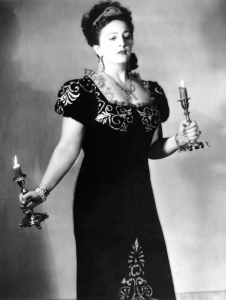
The Great Soprano
In We Sang Better by James Anderson, Mr. Anderson quotes a Dr. Tomastis who says, “Gigli told me the secret of his high notes…It was falsetto accomodato.” The simply means that the falsetto/head voice is the mechanism he used to achieve his high notes. I would argue that it is the mechanism used to achieve the whole voice, regardless of its category. Not too many people mention that do they?
On the contrary, many people think opera singers -whether from today or from the past- are only capable of screaming. These upcoming recordings will show you otherwise. The basis of all masterful loud singing is a soft falsetto/head voice tone. A masterful singer must connect the two into complete harmony, so as to go from one to the other on the same breath without difficulty, throughout the range.
There is a way to do this, and a way to train a voice to do this (which we will explain a little more elsewhere). However, to learn this, we must realize that there is an absolutely true method of training that brings this to the voice (in other words we need to throw out postmodernism). I hope these recordings inspire you with what the human voice is capable of (even though you cannot completely experience this without hearing it live).
Open this playlist in spotify, here.
The exact clips I prepared for the recordings I list here are Otello – 3:07-4:25, La Gioconda – 0:34-1:35, La Sonnambula – 0:00-1:30, Ninon – 2:38-3:30, Danny Boy -0:00-1:40, Ma Bonny Lad 0:00-0:49, Ave Maria -0:00-1:05, and Forbi, Forbi – 5:50-6:36.
I know someone who said that Zinka had the greatest soft notes of anyone he ever heard. She said that humming tones helped her get them. Some teachers like this and others don’t. Listen to how expressive her voice was (which can’t be achieved by forcing the voice), and how much the music compliments it!
In La Gioconda, Gioconda praises Enzo (the man she loves), after he rescues her mother from harm she sings this phrase, “Enzo adorato, O come t’amo,” which means, “Enzo beloved, how I love you!” It is said when Zinka used to sing the soft high note at the end, she would walk off the stage while holding the note and people would go wild. This gives you a chance to hear what soft notes at the very top of the range are like.
Anna Moffo spoke of the mixed voice, and here she exibits it. Imagine mixing the detached chest and head voice together, so that you can have the beauty of the high voice with the power of the bottom voice. It really creates a whole new voice altogether.
Ninon! This is a recording from my favorite opera singer Jan Kiepura. He was famous for his soft notes and diminuendi (which we will get into later). He sings a ravishing Polish song here. Notice how similar his loud and soft voices sound!
This clip will show you how some of the greatest baritones equally structured their voice on the head voice mechanism. This is what allows Leonard Warren to sing very softly here.
Here is a real treat. You don’t hear many singers today sing like this (or sing in this category). Ms. Ferrier is a contralto, who is the lowest woman’s voice. Here she sings part of an Irish song with a very soft, bright, and mellow voice. You can see how even the lowest woman’s voice is based in structure off of the head voice.
This clip is from the movie Serenade starring Mario Lanza. It is a great movie to watch! The toast of New Orleans is another very similar movie starring Lanza. These movies have a lot of the great aspects of society that we are missing today! Also, he shows you how one can gauge the breath to swell or grow the same gorgeous tone without breaks.
In this clip, Björling is singing in Swedish instead of the original Russian the aria was written in. In it, he is predicting that he won’t make it past the duel he is about to engage in. Listen carefully, he sings so softly you can barely hear it!


